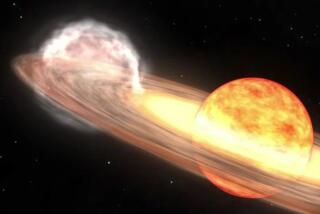Bohdan Paczynski, 67; a key figure in the search for dark matter and planets
Astrophysicist Bohdan Paczynski, who was the first to suggest that gamma-ray bursters lie outside the Milky Way and who revolutionized astronomy by using gravitational lensing as a tool to search for dark matter and new planets, died April 19 in his Princeton, N.J., home after a three-year battle with brain cancer. He was 67.
His novel ideas were often at odds with the conventional wisdom of his peers, but more often than not, he was proved correct, and his insights opened many new areas of research, including the search for stars and other celestial objects whose light output varies over time.
“He was incredibly creative and original,” Princeton astrophysicist Michael Strauss said. “All of his life, he brought interesting approaches to interesting problems.”
Astrophysicist Adam Riess of Johns Hopkins University said, “People often said that if you had a clever idea and were thinking of writing a paper, you had better check with him first.
“When I was in graduate school, I thought it would be neat to look for supernovas in [gravitationally] lensed systems. I looked it up, and he had already described it.”
A native of Poland, Paczynski settled in this country permanently in 1981 when Polish leader Gen. Wojciech Jaruzelski cracked down on the Solidarity trade union movement while Paczynski and his family were in this country on sabbatical.
But he retained close ties with the Polish astronomical community, collaborating with researchers there and creating a pipeline to bring many to the United States for training and research.
“He is basically a legend in Poland,” said astronomer Krzysztof Pojmanski of the Harvard-Smithsonian Center for Astrophysics.
Although he originally made his name studying binary stars — two stars that orbit around each other — his first major contribution involved the gamma-ray bursters, which were discovered accidentally in the 1980s by satellites orbiting to monitor nuclear tests.
These stellar explosions were so bright in the gamma-ray spectrum that astronomers thought they had to be in the Milky Way galaxy. But Paczynski, a theoretical astrophysicist by training, reasoned that they were actually much brighter than astronomers thought, and thus could be anywhere in the universe.
“Other astrophysicists thought he was nuts, but he turned out to be right,” Strauss said.
Paczynski’s interests turned from the theoretical to the practical when he began contemplating Albert Einstein’s proposal that objects with a powerful gravitational field such as stars can focus light from distant objects much like a telescope lens.
He proposed a novel survey of the skies to search for such lensing events, but others scoffed at its apparent impracticality, predicting that such events would be exceptionally rare.
He worked out the technical difficulties, which involved using a large digital camera to survey broad sections of the sky repeatedly and sophisticated computer software to search the images for stars whose light output varied.
He and Polish astronomer Andrzej Udalski of Warsaw University then led a group of astronomers that began the Optical Gravitational Lensing Experiment, or OGLE, in 1992. They soon observed thousands of lensing events, and now the project has its own telescope at the Las Campanas Observatory in Chile.
The information they collected has all been placed on the Internet and made freely available to other scientists. “There is so much data that there is no way that our small team can do all the science with it,” Paczynski said. “Now other people, instead of asking for expensive telescope time, can go to the Internet and get the data they need.”
The OGLE program was also the first to identify planets orbiting other stars, detecting them by the slight dimming of the star as its planet passes between it and the Earth. Last year, the team announced the discovery of the smallest such planet then known, one about 5 1/2 times the mass of Earth.
More recently, Paczynski and Grzegorz Pojmanski of Warsaw University began the All Sky Automated Survey, which uses the same principles to study much larger areas of the sky. The pilot project at Las Campanas has already discovered 50,000 variable stars in the southern skies, as well as two comets.
Bohdan Paczynski was born Feb. 8, 1940, in Wilno, Poland, to Lithuanian immigrants and raised in Warsaw. When he was 14, his mother contacted a Lithuanian astronomer at the Warsaw University Observatory whom she knew from her student days in Lithuania, and said she had a son who was very interested in astronomy.
The young Paczynski then spent subsequent summers looking through a 10-inch telescope at the observatory to examine binary stars — observations that led to his first research studies.
After receiving his doctorate from the university in 1964, he obtained a research assistantship at the University of California’s Lick Observatory on Mt. Hamilton, where he worked with astronomer George Preston. “It took me about 48 hours to figure out that he was smarter than I was,” Preston later told the New York Times.
After settling in the United States, Paczynski spent a year at Caltech before moving to Princeton, where he remained for the rest of his career.
He won a number of major awards, including last year’s Henry Norris Russell Lectureship, the American Astronomical Society’s highest honor. The citation noted that “his research has been distinguished by its creativity and breadth, as well as the stimulus it has provided to highly productive observational investigations.”
Paczynski is survived by his wife, Hanka; a daughter, Agnieszka; and a son, Martin.
thomas.maugh@latimes.com






